 Image search results - "yokozuna" Image search results - "yokozuna" |

Ryogoku Kokugikan sumo arena as seen from Ryogoku Station
|
|

Crowd outside the Kokugikan await their favorite wrestlers.
|
|

Crowd enters the Kokugikan for Musashimaru's retirement ceremony on Oct. 2, 2004.
|
|

Passing out programs
|
|

Musashimaru at the entrance
|
|

Musashimaru greets the crowd
|
|

Hawaii's last sumo wrestler shakes hands.If he were married, his wife would be beside him.
|
|

Musashimaru right after I shook his hand.
|
|

Signboard for retirement ceremony at entrance.It reads "Musashimaru, Intai Danpatsu Hiroo Ozumo" which means "Musashimaru Topknot-Cutting and Retirement Sumo Exhibition."
|
|

Musashigawa stablemaster (former Yokozuna Mienoumi) in the entrance hallInside the entrance hallway, there was a long table on the left side with ribbons which served as name tags for distinguished guests. Musashigawa is the name of Musashimaru's sumo stable.
|
|

Entrance hall is clogged up by a side show of hula.
|
|

Musashigawa Stable wrestlers greet visitorsIncludes Miyabiyama and Musoyama.
|
|

In the entrance hall, hula and Hawaiian music direct from Hawaii
|
|

The retirement ceremony had a lot of Hawaiian touches. This was only the beginning.Hula dancers and live Hawaiian band from Hawaii.
|
|

Konishiki also sings. (His company arranged the entertainment.)
|
|

Musashigawa Stable wrestler wearing Aloha-print yukataFlowery pattern (plumeria) with "Musashimaru" imprinted.
|
|

Musashimaru souvenirs at the Kokugikan's souvenir shop
|
|

Musashimaru merchandise
|
|

Musashimaru doll
|
|
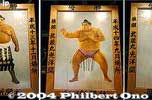
Giant painted pictures of Musashimaru decorating the arena inside. Each one commemorates a tournament victory.These giant pictures are actually black-and-white photographs taken in a photo studio and printed on large paper. Then it is hand-painted in color by a woman who has been doing it for years.
|
|

The ceremony opens with taiko drum beating on the sumo ring.
|
|

Sumo exhibition matches with lower division Makushita wrestlers.A retirement ceremony for an important sumo wrestler includes a variety of activities besides the actual ceremony of cutting away the topknot. It involves almost the entire Japan Sumo Association, and most wrestlers in the top three divisions (Makushita, Juryo, and Makunouchi) also appear in exhibition matches.
|
|

Makushita sumo matchLower-division wrestlers wear black belts, while the upper division wrestlers wear white belts (during practice) or colored belts during official matches.
|
|

Juryo Division dohyo-iri ring-entering ceremony
|
|

Juryo sumo match
|
|

Hairdressing demonstration
|
|

Sumo match with kidsA retirement ceremony for an important sumo wrestler includes a variety of activities besides the actual ceremony of cutting away the topknot. It involves almost the entire Japan Sumo Association, and most wrestlers in the top three divisions (Makushita, Juryo, and Makunouchi) also appear in exhibition matches.
|
|

A retirement ceremony for an important sumo wrestler includes a variety of activities besides the actual ceremony of cutting away the topknot. It involves almost the entire Japan Sumo Association, and most wrestlers in the top three divisions (Makushita, Juryo, and Makunouchi) also appear in exhibition matches.
|
|
|
|

The kids gradually get bigger.
|
|

Ozeki Musoyama is defeated.
|
|

Yobidashi wearing Aloha-print garb
|
|
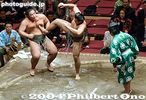
Comic sumo (shokkiri sumo)This is comedy time with two young wrestlers performing various comical antics (spitting at each other, kicking, and other illegal sumo acts) on the ring.
|
|

Comic sumo (shokkiri sumo)This is comedy time with two young wrestlers performing various comical antics (spitting at each other, kicking, and other illegal sumo acts) on the ring.
|
|

Tidying up the ring
|
|

Musashimaru finally appears for a yokozuna belt demo
|
|

Musashimaru acknowledges a spectator as he proceeds to the ring.This was a demonstration on how they tie on the thick, white rope (tsuna) around his waist. The tsuna is the symbol of the yokozuna. It takes several assistants to put it on. They are all wearing white gloves.
|
|

Yokozuna "tsuna" belt demo
|
|

They wrap the rope around his waist from the front, or the thickest part of the rope.This was a demonstration on how they tie on the thick, white rope (tsuna) around his waist. The tsuna is the symbol of the yokozuna. It takes several assistants to put it on. They are all wearing white gloves.
|
|

Pulling it tight
|
|
|
|

Tying the rope at the back.
|
|

Rear view of the shiranui style of tying the rope.He turned in all four directions to show everyone what it looked like. This is what is called the shiranui style of tying the rope. It is characterized by a single loop in the back. The other style, called unryu, has twin loops.
|
|

Musashimaru goes back and then comes back...
|
|
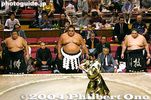
He performs his last yokozuna dohyo-iri ring-entering ceremony. He is flanked by Musoyama on the left as the sword bearer, and Miyabiyama on the right as the dew sweeper.
|
|

Musashimaru's final dohyo-iriHe could have had Yokozuna Asashoryu be either the sword bearer or dew sweeper, but he chose to have his stablemates to join his final dohyo-iri.
|
|

Musashimaru's final dohyo-iri
|
|

Musashimaru's final dohyo-iri
|
|

Musashimaru's final dohyo-iri
|
|

Musashimaru's final dohyo-iri ends
|
|

He goes back to the dressing room
|
|
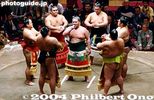
Sumo jinkuThey are singing sumo jinku, a chant-like song about sumo and sumo wrestlers. They are singing about Musashimaru and his career.
|
|

Laying the red carpet for the main event.
|
|

This must be a first, a kumu hula (hula teacher) from Hawaii performing on the sumo ring.He is Sonny Ching, a well-known hula teacher in Hawaii. He brought four male hula dancers who danced at the four corners of the ring.
|
|

Kumu hula Sonny Ching beats the ipu gourd drum, a traditional Hawaiian instrument. This must be a first, a kumu hula performing on the sumo ring in Japan.
|
|

Male hula dancer at one cornerThe original plan was for the hula dancers to perform on the ring itself. But at the last minute, Musashimaru decided that it was not appropriate so they danced outside the ring.
|
|

Calling Musashimaru (with a conch shell)
|
|

Here he comes...
|
|

Head supporter speaks
|
|

The chair
|
|
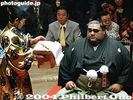
The scissors (golden)I think it was given by French President Chirac who is a sumo fan.
|
|
|

Snip by actor Hiroshi Fujioka, who played Kamen Rider in the '70s.
|
|

Oh, I gotta take a picture of this...Look at the gyoji referee who must be thinking, "C'mon, hurry up!"
|
|

Snip by singer Shigeru MatsuzakiFamous for his classic hit, "Ai no Memory."
|
|

Konishiki is called and he enters
|
|
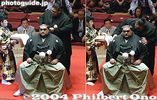
Snip and a hug by Konishiki (Question: Where was Akebono??)
|
|

Snip by Musashimaru's brother
|
|
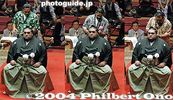
More blood relatives (or brothers)
|
|

Snip by Kitanoumi, the head of the Japan Sumo Association
|
|

Snip by Yokozuna Asashoryu and a symbolic passing of the baton from one foreign yokozuna to the next (and only) foreign yokozuna.Mongolia's Golden Age of Sumo has begun.
|
|

Snip by stablemate Ozeki Musoyama
|
|

He was grim-faced all throughout
|
|
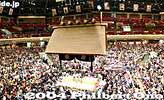
Panoramic shot of the KokugikanNotice the upper floor was quite empty, similar to Akebono's retirement ceremony.
|
|

Awaiting the final cut as we listen to one of his famous matches.
|
|

The final cut by stablemaster Musashigawa Oyakata.
|
|

Musashimaru minus his topknot
|
|

The End of Hawaii's Golden Age in sumo. For the first time since 1968, no wrestler from Hawaii is in the top Makunouchi division.
|
|

Nephews give a flower bouquet (they can step on the sumo ring)
|
|

His mom is next...
|
|

But his mom cannot step on the sumo ring...Females are prohibited from entering the sumo ring. Barring women from stepping onto the sumo ring, even to give an award to a wrestler, is one of the most blatant and preposterous forms of sexual discrimination in Japan. It was devised centuries ago, and for the sake of tradition, traditionalists in the sumo world have maintained this extremely absurd custom and belief that women are considered to be impure (due to menstruation). I'm not saying this as a gaijin (foreigner) who likes to criticize Japan or the Japanese. Nor am I saying this as a women's rights advocate. I say this from the standpoint of plain, old common sense.
Up to 1909, women were actually not allowed enter a sumo arena to view sumo matches. And once upon a time, women were prohibited from setting foot on sacred Mt. Fuji. Can you imagine if these traditions were still being practiced today?
Such discriminatory practices were abolished long ago, and here we are in the 21st century with women still unable to step into the sumo ring. The Japan Sumo Association has constantly rejected requests from important female ministers in the Prime Minister's Cabinet to give an award to the tournament winner in the sumo ring.
|
|

Musashimaru and his flowersThis was his last appearance at this retirement ceremony.
|
|

Makunouchi dohyo-iriNext was exhibition sumo matches by the top-division Makunouchi wrestlers. Musashimaru never appeared again.
|
|

Makunouchi dohyo-iri
|
|

Makunouchi dohyo-iri
|
|

Makunouchi dohyo-iri
|
|

Makunochi dohyo-iri ring-entering ceremony
|
|

Yokozuna Asashoryu performs his dohyo-iri ring-entering ceremony
|
|

Taiko drum demonstration
|
|

"Robocop" Takamisakari gets readyThe top-division Makunouchi wrestlers went through their matches quickly.
|
|

Takamisakari wins
|
|
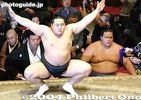
Final match of the day with Yokozuna Asashoryu
|
|

Asashoryu in the face-off
|
|

Asashoryu later won
|
|

Yumitori-shiki bow-twirling ceremony
|
|

Exiting the building
|
|
|
|
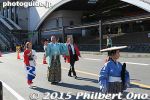
Hanada Masaru
|
|

JR Koiwa Station has this statue of Yokozuna Tochinishiki, a famous sumo wrestler who was from Koiwa.
|
|

Statue of Yokozuna Tochinishiki (1925-1990) inside JR Koiwa Station. The statue is now a popular meeting place inside the station.
|
|

Statue of Yokozuna Tochinishiki inside JR Koiwa Station. He was the 44th yokozuna and head of the Japan Sumo Association during 1974-1988. The new and current Kokugikan was built under his watch.
|
|

It's a very good likeness, and almost life-size. After retiring as an active wrestler, he became Kasugano oyakata.
|
|

Very well done, and wise to put it inside the station where birds cannot sully it.
|
|

Back view.
|
|
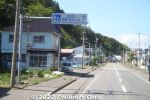
Road signs in Fukushima, Matsumae point the way to Yokozuna Chiyonoyama and Chiyonofuji Memorial Hall.
|
|

Road signs in Fukushima, Matsumae indicate you're in a Yokozuna town.
|
|
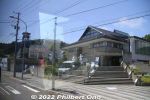
Approaching Yokozuna Chiyonoyama and Chiyonofuji Memorial Hall.From JR Kikkonai Station, take a bus to Matsumae and get off at Fukushima bus stop. Takes alomst an hour. Open 9 am–5 pm. Admission ¥500. Cloeed Dec. 1 to March 15. https://be-happy-fukushima.com/attractions/yokozuna-kinenkan/
|
|
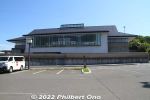
Side view of Yokozuna Chiyonoyama and Chiyonofuji Memorial Hall.
|
|
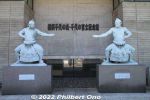
In front of the museum is a statue of Chiyonofuji (left) and his stablemaster/recruiter Chiyonoyama.
|
|
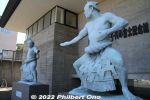
In front of Yokozuna Chiyonoyama and Chiyonofuji Memorial Hall, statues of Chiyonofuji and Chiyonoyama.
|
|
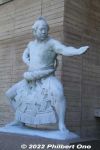
Chiyonofuji was one of the greatest grand champion (yokozuna) sumo wrestlers of all time. And one of the most popular of all time. For a sumo wrestler, his physique was relatively small and lightweight, but he compensated for it with his muscular strength, agility, and expert technique.
|
|
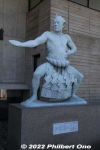
Statue of Chiyonoyama.
|
|
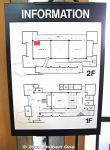
Museum floor plan. Two floors.
|
|
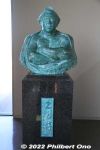
Bust of Chiyonofuji.
|
|

Biography of the two yokozuna.
|
|

About Chiyonofuji. His sister used to be the museum director.
|
|
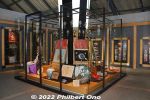
Chiyonofuji's trophy room, filled with trophies, awards, and mawashi ceremonial aprons.
|
|
|
|

Various awards.
|
|
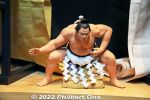
Small statue of Chiyonofuji performing the dohyo-iri ring-entering ceremony.
|
|

Chiyonofuji's yokozuna rope belt.
|
|
|
|
|
|
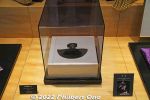
Chiyonofuji's topknot is also displayed. His topknot was cut off on his retirement day in Feb. 1992 by his then Kokonoe stablemaster and former Yokozuna Kitanofuji.Chiyonofuji's topknot is also displayed.
|
|
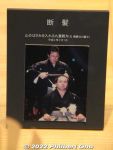
Chiyonofuji's topknot was cut off on his retirement day in Feb. 1992 by his then Kokonoe stablemaster and former Yokozuna Kitanofuji.
|
|
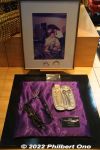
Scissors used to cut Chiyonofuji's hair on his retirement day.
|
|
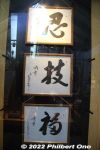
Chiyonofuji's motto: Shin-gi-tai or Mind, Technique, and Body. 心技体
|
|
|
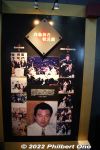
About Chiyonofuji.
|
|

Outstanding Father Award for Chiyonofuji.
|
|
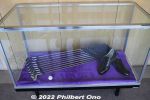
Chiyonofuji's golf clubs.
|
|

About Chiyonoyama.
|
|

Chiyonoyama opened the Kokonoe Stable and recruited Chiyonofuji.
|
|
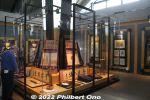
Chiyonoyama's trophy room.
|
|
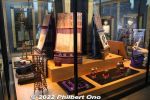
Chiyonoyama's trophy room.
|
|
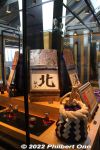
Chiyonoyama's trophy room.
|
|
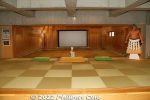
The museum also has a replica of Chiyonofuji's Kokonoe sumo stable ring.
|
|
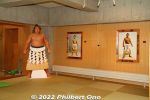
After retiring, Chiyonofuji took over Kokonoe sumo stable from former Yokozuna Kitanofuji.
|
|
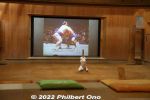
The video screen showed noted sumo matches such as between Chiyonofuji and Kitanoumi.Kitanoumi also has an impressive sumo museum near Lake Toya in Hokkaido: https://photoguide.jp/pix/thumbnails.php?album=664
|
|

Photo of actor Sylvester Stallone visiting Kokonoe Stable and Chiyonofuji practicing.
|
|
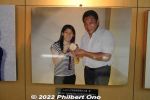
Photo of Olympic gold medalist wrestler Yoshida Saori and Chiyonofuji.
|
|
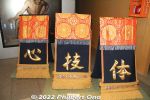
Chiyonofuji's motto: Shin-gi-tai or Mind, Technique, and Body. 心技体
|
|
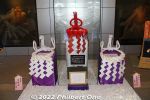
Chiyonofuji's Kanreki (age 60) yokozuna rope belt in red.
|
|
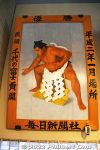
Photo portrait of Chiyonofuji for his tournament victory. Sadly, Chiyonofuji died of cancer in 2016 at age 61. Major loss of a beloved, sumo legend.
|
|

Yokozuna Hakuho and his yokozuna rope to be put around him by his attendants.
|
|

Yokozuna Hakuho and his yokozuna rope belt.
|
|

Demonstration of putting on the yokozuna rope belt on Yokozuna Hakuho.
|
|

This is something we don't seeing during regular grand sumo tournaments held every other month in Tokyo (3 times), Osaka, Nagoya, and Fukuoka.
|
|

Pulling it tight.
|
|
|

This is the Shiranui style with two loops in the back. The rope has a wire core to stiffen the rope. 横綱白鵬 不知火型
|
|

He faced all four directions before stepping down from the ring.
|
|
|

Now the Yokozuna dohyo-iri ring-entering ceremony.
|
|

They set up up to the ring.
|
|

Yokozuna Hakuho performs the yokozuna dohyo-iri ring-entering ceremony.
|
|

Yokozuna Hakuho performs the yokozuna dohyo-iri ring-entering ceremony.
|
|

The Yokozuna Kitanoumi Ki'nenkan or Memorial Hall looks like a miniature version of the Ryogoku Kokugikan sumo arena in Tokyo. Although it's near Lake Toya, it's off the main tourist road. There is a bus stop nearby, but I rented a bicycle.
|
|

Front of the Yokozuna Kitanoumi Memorial Hall, dedicated to Sobetsu's most famous son. Yokozuna Kitanoumi was one of sumo's greatest grand champions in modern times. "Kitanoumi" means "Lake of the North," and this refers to Lak
|
|

Today, Kitanoumi is a stablemaster and the chairman of the Japan Sumo Association. The front entrance of the Yokozuna Kitanoumi Memorial Hall which opened in May 1991..
|
|

Right outside the Yokozuna Kitanoumi Memorial Hall are sumo banners. From left to right, they read, "Kitanoumi Stable," "Yokozuna Kitanoumi Memorial Hall," and "Sobetsu History Museum."
|
|

This is what you first see. Photos of Kitanoumi growing up in Sobetsu town. Looks like any ordinary kid. Admission is 250 yen for adults, 100 yen for kids. Open 9 am to 5 pm, closed Jan. 1.
|
|

Little Kitanoumi. He was born in May 1953 in Sobetsu-cho town which includes the eastern shore of Lake Toya (Toyako). At age 13, he moved to Tokyo and entered the Mihogaseki Stable.
|
|

Kitanoumi as a young sumo wrestler. Even as Ozeki, he already had the aura of a Yokozuna. He had an ideal sumo physique, quiet dignity, and awesome sumo technique and power. He was a shoo-in to be a yokozuna.
|
|

In July 1974, he became the youngest sumo wrestler to be promoted to Yokozuna at age 21. His 18-year sumo career included 24 tournament championships.
|
|

This is the main room of the Kitanoumi Memorial Hall. It includes half of a sumo ring (dohyo) with a mannequin.
|
|

The sumo ring is not made of real dirt.
|
|

Top row has miniature versions of the tournament champion portraits awarded to the wrestler and hung in the Ryogoku Kokugikan. Bottom row of photos show his best career moments.
|
|

Some photos are captioned with memorable quotes by Kitanoumi.
|
|

The mannequin is a slightly larger-than-life likeness of Yokozuna Kitanoumi performing the Yokozuna Dohyo-iri (ring-entering ceremony). Yokozuna Kitanoumi Memorial Hall, Sobetsu, Hokkaido
|
|

Above is an actual tournament champion giant portrait which once hung in the Kokugikan.
|
|

He is doing the Unryu-style dohyo-iri.
|
|

It sort of looks like Kitanoumi...
|
|

Actual-size ringside seats are also on display.
|
|

It looks kind of strange without his two attendants, the sword bearer and dew sweeper...
|
|

Kitanoumi's kesho mawashi set (ceremonial apron) on display.
|
|

His Yokozuna "tsuna" rope belt.
|
|

And some of his trophies. Besides the Emperor's Cup (not displayed), the tournament champion receives numerous trophies and awards from various organizations and countries.
|
|

Kitanoumi-beya stable sign at top, and various award certificates.
|
|

Award from Czechoslovakia in 1978.
|
|

Scale model of a sumo drum tower
|
|

Tournament champion portrait. Kitanoumi retired in Jan. 1985 and started his own Kitanoumi Stable. In 2002, he became chairman of the Japan Sumo Association. We missed Kitanoumi, but another great Yokozuna from Hokkaido, Chiyonofuji, filled the void.
|
|

Photos of other tournament champions. Six official 15-day sumo tournaments are held every year in Tokyo, Osaka, Nagoya, and Fukuoka.
|
|

Referee costumes in the showcase.
|
|

Sacred offerings buried in the dohyo before each tournament.
|
|

The other half of the building is the Sobetsu History Museum. This panel shows how Lake Toya was formed.
|
|

Typical abode of early Hokkaido settlers who first came to this area in 1879.
|
|

Artifacts of early Hokkaido settlers.
|
|

Artifacts from the defunct local Iburi rail line discontinued in 1986. There was a Sobetsu Station.
|
|
|

Power generation machinery
|
|

Natural history exhibit
|
|

Local wildlife exhibit, including the Ezo deer.
|
|

Kitanoumi souvenirs for sale.
|
|

Yokozuna Rikishi Monument (Yokozuna Rikishi-hi) at Tomioka Hachimangu Shrine, Koto Ward, Tokyo 横綱力士碑
|
|

Main stone of Yokozuna Rikishi Monument is inscribed with "Yokozuna Rikishi-hi" (横綱力士碑) which means Yokozuna Monument.
|
|

The left stone has a drawing of Yokozuna Shiranui.
|
|

The right stone shows Yokozuna Jimmaku Kyugoro.
|
|

Shiranui verses...
|
|

Jimmaku
|
|

On the right of the centerpiece stone is this newer stone (added in 1983) inscribed with the names of the most recent yokozuna.
|
|

The stone has three rows with seven names each.
|
|

In the top row, we can see from right to left: Asashio, Kashiwado, Taiho, Tochinoumi, Sadanoyama, Tamanoumi, and Kitanofuji. Inscribed are the ring name, hometown, and yokozuna promotion date.
|
|

In the middle row, from right to left: Kotozakura, Wajima, Kitanoumi, Wakanohana (II), Mienoumi, Chiyonofuji, and Takanosato.
|
|

On the bottom row, right to left: Futahaguro, Hokutoumi, Onokuni, Asahifuji, Akebono, Takanohana, and Wakanohana (III).
|
|

Since the front side of this stone is full, it continues on the back as you can see here.
|
|

From right to left: Musashimaru, Asashoryu, and Hakuho. Whenever a new yokozuna is promoted, a name inscription ceremony is held here.
|
|

The centerpiece stone is a 3.5-meter tall, 20-ton monument made in 1900 by the 12th yokozuna Jinmaku Kyugoro after collecting donations from business and political circles.
|
|

Behind the centerpiece stone are 45 yokozuna names (from the first yokozuna up to Wakanohana I) inscribed.
|
|

Names of the first to fifth yokozuna on the centerpiece stone. The first yokozuna was Akashi Shiganosuke. The Edo Period's golden age of sumo was during the time of the 4th yokozuna Tanikaze and 5th yokozuna Onogawa around 1789.
|
|

Names of yokozuna inscribed on the back of the centerpiece stone.
|
|

Names of yokozuna inscribed on the back of the centerpiece stone.
|
|

Names of yokozuna inscribed on the back of the centerpiece stone. On the extreme left is Raiden's name, a special case who was never promoted to Yokozuna, but was certainly Yokozuna material during the Edo Period..
|
|

At the time, only two ten-day tournaments were held annually in front of several thousand people. The sumo ring was located at the site of the present primary school next to the shrine.
|
|

During the years when tournaments were held at the shrine, professional sumo saw many important developments such as the incorporation of the yokozuna dohyo-iri (ring-entering ceremony), the establishment of the banzuke (sumo wrestler ranking sheet),
|
|

and the opening of sumo stables. Fukagawa (the area where the shrine is located) in effect became the birthplace of modern sumo.
|
|

The third stone awaits (still blank).
|
|

In 1791, the fund-raising sumo tournaments were moved to Eko-in temple in Ryogoku. In 1833, official sumo tournaments started at Eko-in temple. In 1909, the first and original Kokugikan sumo arena was subsequently built next to the temple.
|
|

The Yokozuna Rikishi Memorial Monument is also flanked by this smaller monument on the left. This is for sumo rikishi who acheived more than 50 consecutive wins.
|
|

This Rikishi Monument for Over 50 Consecutive Wins has 10 sides, and only five sides are inscribed with names. Which means only five rikishi have achieved more than 50 consecutive wins. One of them is Chiyonofuji.
|
|

Yokozuna Jimmaku Kyugoro
|
|

Although the shrine no longer hosts sumo tournaments, it has maintained close ties to sumo ever since. As of 2008, Koto Ward has several sumo stables (Taiho, Kitanoumi, Musashigawa, Kasugayama, Oshiogawa, Ajigawa, and Tomozuna).
|
|
|
|